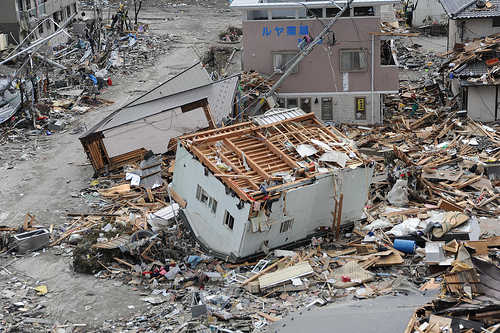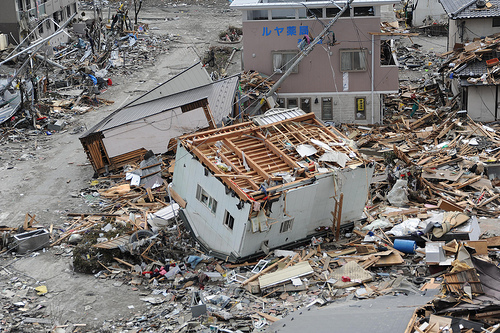 Japan’s been through a lot in just one week.Photo: Matthew BradleyLast Friday, Japan was rocked by a magnitude 9.0 quake — its most powerful earthquake on record, and the strongest anywhere in the world in the past 140 years — with its epicenter off the coast, creating a 30-foot-high tsunami that swallowed up whole towns and killed more than 5,000 people. The tsunami waves knocked out the cooling systems at the Fukushima Daiichi nuclear power plant in northern Japan, creating a nuclear disaster that has worsened over the days since the natural disaster struck.
Japan’s been through a lot in just one week.Photo: Matthew BradleyLast Friday, Japan was rocked by a magnitude 9.0 quake — its most powerful earthquake on record, and the strongest anywhere in the world in the past 140 years — with its epicenter off the coast, creating a 30-foot-high tsunami that swallowed up whole towns and killed more than 5,000 people. The tsunami waves knocked out the cooling systems at the Fukushima Daiichi nuclear power plant in northern Japan, creating a nuclear disaster that has worsened over the days since the natural disaster struck.
Two of the six reactors in the complex appear to have suffered partial meltdowns, releasing large amounts of radioactivity. This makes the disaster far worse than the Three Mile Island accident in Pennsylvania in 1979, but not as bad as Chernobyl in 1986.
As radiation climbs to “extremely high” levels just 50 workers remain. The release of radiation could worsen again, as the uranium fuel rods may restart their nuclear chain reactions, spreading more radiation.
Nearly 200,000 people were evacuated from the area surrounding the nuclear plant, and the humanitarian crisis continued; many parts of Japan still lack power and access to food has been difficult. As winds shifted to blow some of the radiation south, toward the capital of Tokyo, Japan’s prime minister warned those living within 20 miles of the plant to stay indoors. But the U.S. government warned Americans in Japan to stay much farther away from the nuclear site, as did other foreign nationals, with Austria moving its embassy from Tokyo to the southern city of Osaka.
Early warnings: According to a diplomatic cable leaked by WikiLeaks, the International Atomic Energy Agency had warned Japan more than two years ago its safety measures were out of date, and that strong earthquakes would pose “serious problems” for their nuclear reactors. But Japan has had “an unfortunate track record of downplaying or concealing mishaps,” according to the think tank Chatham House. As early as 1972, regulators were warned about apparent flaws in the design of the reactors in Japan — the Mark 1 model.
Global warming link?: Although nuclear power has been touted as a source of electricity that contributes little to global warming, now any kind of nuclear renaissance will face much higher hurdles, according to several analysts. Already, the disaster has given a boost to renewable energy, The Guardian reports.
Within a few hours of the earthquake, a few people were posting on Twitter that the temblor seemed linked to global warming, but The Gazette says such an effect is unlikely to be connected to Japan’s quake. To try to counter misconceptions and rumors, many news sites are providing backgrounders, including a map of all the world’s nuclear power plants, explanations of what happens in a meltdown, answers to common questions about the quake and its aftermath, and a rebuttal of five myths about nuclear power. The New York Times also has pages giving the latest status of all six reactors in the complex, and a forecast of a plume of radioactivity, predicted to waft across to America’s Pacific coast by Friday.
World’s nuclear course shifting: “U.S. nuclear facilities remain safe,” said Gregory Jaczko, U.S. Nuclear Regulatory Commission chair, in his congressional testimony — although 23 reactors in the country use the Mark 1 design that failed in Japan.
Other countries have vowed to swiftly change their nuclear course. Following protests by more than 100,000 anti-nuclear activists across Germany, the country plans to shut down seven of its oldest nuclear plants. Since nuclear supplies about a quarter of Germany’s electricity, the sudden change in direction may cause Germany to miss targets for cutting greenhouse-gas emissions. Several other European countries have called for nuclear power reviews, shut-downs, or delays. However, the world’s moprst nuclear-reliant country, France, stood by its nuclear industry, while ordering safety reviews of all 58 of their reactors.
Some other countries have remained firm in their commitment to expanding nuclear power, such as Russia. Meanwhile, mixed signals have come from Chinese sources, with The New York Times reporting China is slowing its planned nuclear expansion. Chile’s president insisted on signing a nuclear accord with President Obama during a meeting planned for next week.
Food fight in congressional cafeteria: Meanwhile, back in Washington, D.C., the new Congress has been beating back some of the changes put in place recently — including in the cafeteria. Four years ago, Nancy Pelosi, then House speaker, had put in place many changes to cut Congress’s carbon footprint, including biodegradable utensils and trays made from corn. Now Republicans have reversed these measures, bringing back styrofoam cups and, as the new speaker’s press secretary put it in a tweet, “The new majority — plasticware is back.”
Back in the halls of Congress, a committee passed a bill to block the U.S. Environmental Protection Agency from regulating greenhouse gases. Before it passed the committee, two Democrats tried to add an amendment to recognize global warming is real, and people are causing it — but Republicans rejected the addition. So another, more conservative Democrat added another amendment that said climate change is real — but avoided blaming people — and that did win enough votes to get added.
The Climate Post offers a rundown of the week in climate and energy news. It is produced each Thursday by Duke University’s Nicholas Institute for Environmental Policy Solutions.



